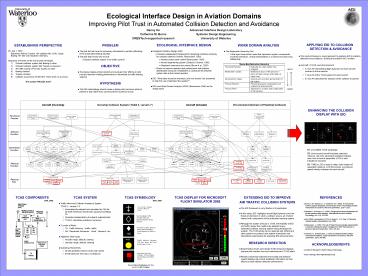TCAS - WATCHI - PowerPoint PPT Presentation
1 / 1
Title: TCAS - WATCHI
1
Ecological Interface Design in Aviation
DomainsImproving Pilot Trust in Automated
Collision Detection and Avoidance
Advanced Interface Design Laboratory Systems
Design Engineering University of Waterloo
Danny Ho Catherine M. Burns CRESTech-supported
research
- APPLYING EID TO COLLISION DETECTION AVOIDANCE
- This study introduces a novel approach to
applying EID to collision detection and
avoidance, dividing the problem into 3 entities - (A)ircraft, (T)CAS, and (E)nvironment
- A One AH representing flight dynamics for each
aircraft involved in the encounter - T One AH of the TCAS system for each aircraft
- E One AH describes the airspace of the collision
encounter
- ECOLOGICAL INTERFACE DESIGN
- Ecological Interface Design (EID)
- A domain-independent framework for designing
interfaces primarily for complex systems
(Vicente, Rasmussen, 1992) - Nuclear power plant control (Rasmussen, 1985)
- Aircraft engineering system (Dinadis Vicente,
1999) - Shipboard command and control (Burns et al.,
2000) - Shown to improve operator task performance and
problem identification because it establishes a
contextual link between system data to the
trained operator - EID What data should be extracted, and how
should it be presented to help the user
understand the system? - EID uses Work Domain Analysis (WDA) (Rasmussen
1985) as the design basis
- PROBLEM
- The pilot did not have the necessary information
to perform effectively in the automated alerting
situation - The pilot didnt know who to trust
- Onboard collision system or air-traffic control?
- OBJECTIVE
- To propose display enhancements and evaluate
their effects on pilot trust and decision making
performance in automated air traffic alerting
systems - HYPOTHESIS
- The EID methodology should create a display that
convinces pilots to perform a task rather than
command them to perform a task
ESTABLISHING PERSPECTIVE On July 1,
2002 Bakshirian Airlines Tupolov 154 collided
with a DHL Cargo Boeing 757-200 over Southern
Germany Sequence of events as the two aircraft
converged 1) Onboard collision system told
Boeing to climb 2) Onboard collision system told
Tupolov to descend 3) Air traffic control (ATC)
told Tupolov to climb 4) Boeing
climbed 5) Tupolov climbed 6) Collision
occurred at 35,000 feet. There were no
survivors. The system FAILED! How?
- WORK DOMAIN ANALYSIS
- The Abstraction Hierarchy (AH)
- A five layer hierarchical model that represents
system components and their interaction, vertical
interpretation is a means-end (how-why)
relationship
ENHANCING THE COLLISION DISPLAY WITH EID
- TCAS SYSTEM
- Traffic Alerts and Collision Avoidance System
- TCAS 2 version 7.0
- Internationally adopted and mandated by FAA for
all North American aircraft with capacity
exceeding 30 - Operates independently of onboard systems/radar
- TCAS 2 calculates avoidance maneuver
- 2 Levels of Alerts
- TA Traffic Advisory - traffic, traffic
- RA Resolution Advisories - climb, descend,
etc. - Algorithm Data Inputs
- intruder range, altitude, bearing
- ownship range, altitude, bearing
- Operating Parameters
- aircraft protected volume varies with speed
- threat based on time (tau), not distance
- REFERENCES
- Burns, C.M., Bryant, D.J., Chalmers, B.A.
(2000). A work domain model to support shipboard
command and control. Proceedings of IEEE
Transactions on Systems, Man and Cybernetics.
2228 2233. - Dinadis N., Vicente, K.J. (1999). Designing
functional visualizations for aircraft systems
status displays. International Journal of
Aviation Psychology. Vol. 9 (3), 241-269. - FAA (2000). Introduction to TCAS II Version 7.
U.S. Dept. of Transport. Federal Aviation
Administration. Nov. 2000. - Rasmussen, J. (1985). The role of hierarchical
knowledge representation in decision-making and
system management. IEEE Transactions on Systems,
Man and Cybernetics, 15(2), 234-243. - Vicente, K.J. Rasmussen, J. (1992). Ecological
interface design Theoretical foundations. IEEE
Transactions on Systems, Man and Cybernetics,
22(4) 589-606 - ACKNOWLEDGEMENTS
- Centre for Research in Earth Space Technology
- Sion Jennings, NRC Flight Research Lab
- EXTENDING EID TO IMPROVE
- AIR TRAFFIC COLLISION SYSTEMS
- The EID framework is very flexible in its
application - In this study, EID highlights aircraft flight
dynamics and the threat environment in which a
collision occurs, all of which interact with
components of the automated warning system. - Although the system of focus is TCAS, the
flexibility of EID and WDA allows this model to
be adapted to any automated collision warning
system being developed for aviation. The TCAS
entity can be replaced with ADS-B and other
systems to produce new system interactions and
information requirements for exploring
EID-enhancements - RESEARCH DIRECTION
- Experimental results will indicate if
EID-enhanced displays improve pilot reaction time
and conformance to TCAS alerts - Results comparison between time-scaled and
distance-scaled displays will provide additional
information on their effects on pilot collision
detection performance
(FAA, 2000)
(FAA, 2000)

